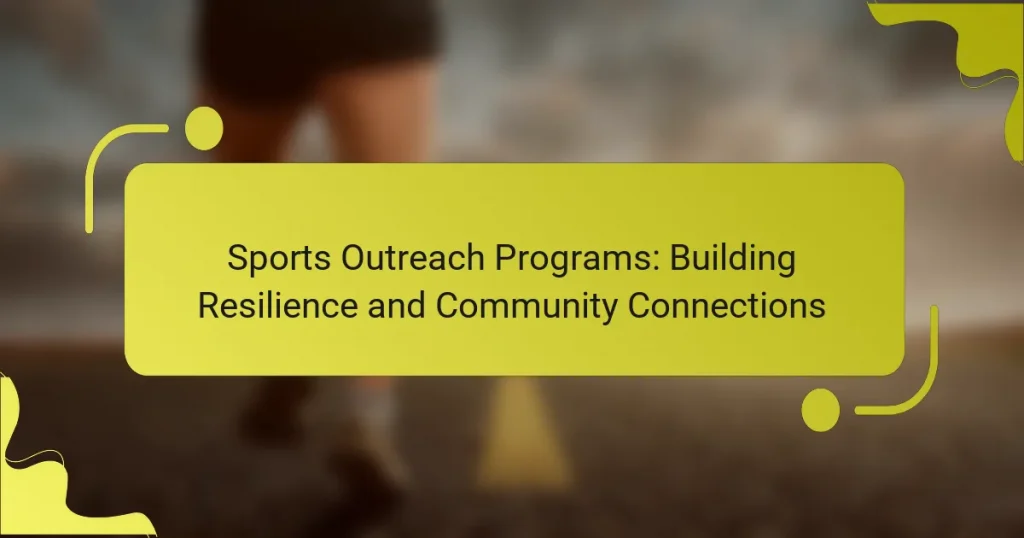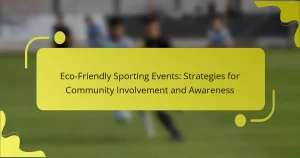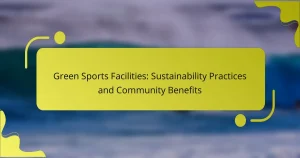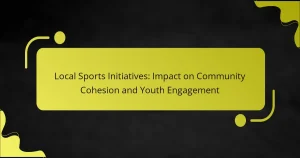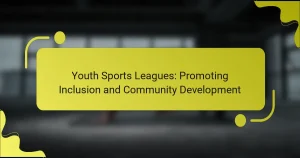Sports outreach programs play a crucial role in fostering community engagement and promoting physical health. They face challenges such as funding shortages and resource allocation while aiming to build resilience among participants. Successful initiatives leverage partnerships and cultural relevance to enhance inclusivity and sustainability. Measuring impact through participant feedback and community connections is essential for ongoing support and improvement.
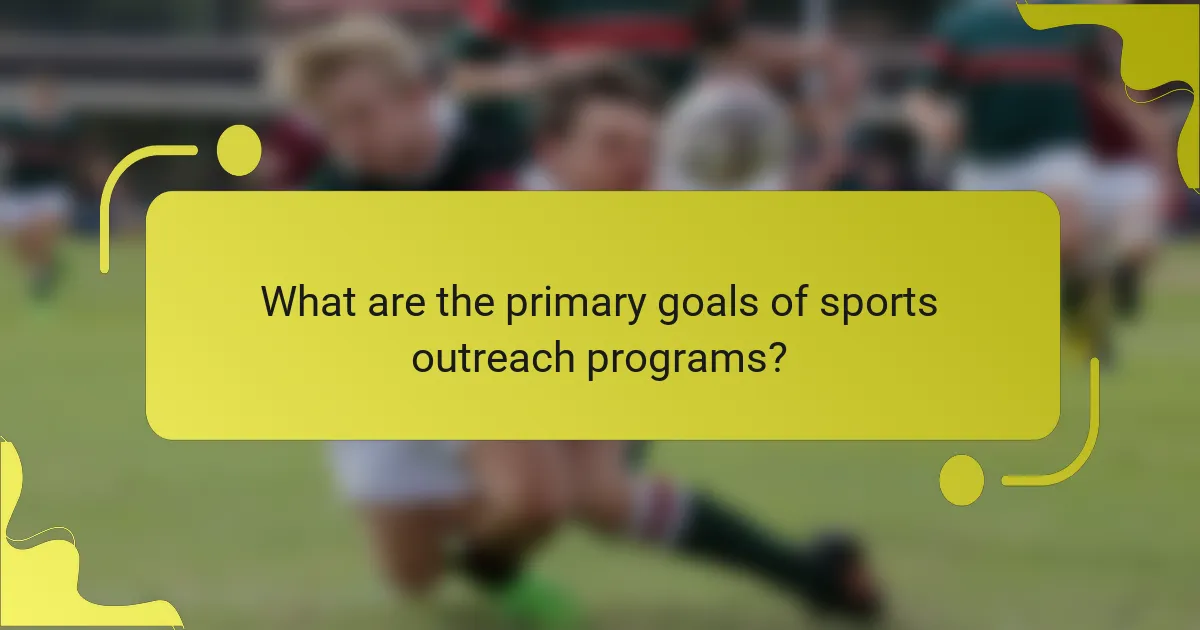
What are the primary goals of sports outreach programs?
The primary goals of sports outreach programs include fostering community engagement, promoting physical health, and building resilience among participants. These programs aim to connect diverse groups, enhance social skills, and provide opportunities for personal development. For instance, they often target at-risk youth, helping them develop teamwork and leadership abilities. Additionally, outreach initiatives can improve access to sports facilities, encouraging a more active lifestyle.
How do these programs foster community resilience?
Sports outreach programs foster community resilience by promoting social connections, enhancing physical health, and encouraging teamwork. These programs provide safe environments for individuals to engage, build relationships, and share experiences. For example, team sports can create a sense of belonging and support networks that help communities withstand challenges. Additionally, they often incorporate skill-building workshops, empowering participants with tools to navigate life’s obstacles. Overall, these initiatives strengthen community ties and enhance collective well-being.
Why is youth engagement crucial in outreach initiatives?
Youth engagement is crucial in outreach initiatives because it fosters community connections and builds resilience. Engaging young people empowers them to contribute positively to their communities. This involvement enhances their social skills and encourages leadership development. Programs that prioritize youth participation often see increased commitment and sustainable impact. Additionally, youth engagement can lead to innovative solutions tailored to community needs, ensuring programs remain relevant and effective.
Which sports are most commonly utilized in outreach efforts?
Team sports like basketball, soccer, and volleyball are most commonly utilized in outreach efforts. These sports foster teamwork, build resilience, and enhance community connections. Individual sports such as running and tennis are also effective, promoting personal growth and discipline. Programs often leverage these sports to engage diverse populations and facilitate social inclusion.
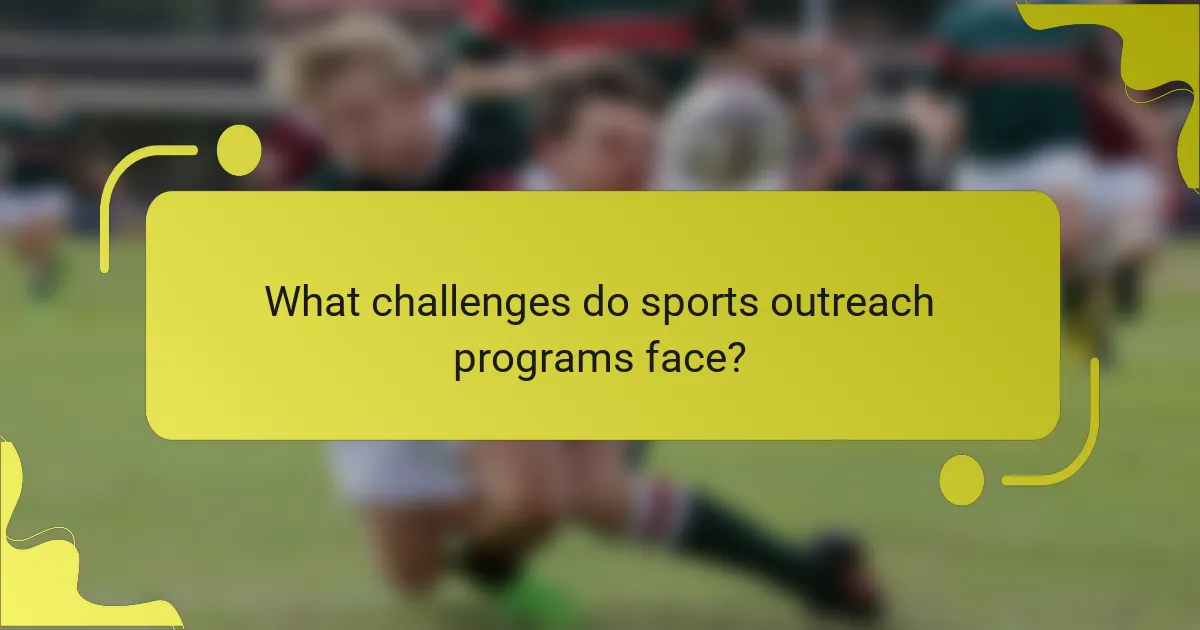
What challenges do sports outreach programs face?
Sports outreach programs face challenges such as funding shortages, community engagement, and resource allocation. These issues can hinder their ability to deliver consistent support and opportunities.
Funding shortages often limit program reach and sustainability. Many programs rely on grants and donations, which can fluctuate. Community engagement is crucial; without local support, programs struggle to attract participants.
Resource allocation presents another challenge, as programs must balance limited staff and facilities. This can affect the quality of training and resources available to participants.
Additionally, measuring impact can be difficult. Programs need effective metrics to demonstrate success and secure ongoing support. Addressing these challenges is essential for fostering resilience and community connections.
How can funding impact program effectiveness?
Funding significantly enhances the effectiveness of sports outreach programs by providing necessary resources. Adequate financing allows for better facilities, training, and equipment, directly impacting program quality. Programs with strong funding can hire experienced coaches and support staff, fostering a positive environment for participants. Furthermore, financial support enables outreach initiatives to expand their reach, engaging more community members and building resilience through sports.
What are the common barriers to participation?
Common barriers to participation in sports outreach programs include lack of access, financial constraints, and limited awareness. Geographic isolation can hinder involvement, while cultural factors may discourage engagement. Additionally, physical disabilities and time constraints often prevent individuals from participating. Addressing these barriers is essential for fostering resilience and community connections.

How do sports outreach programs measure success?
Sports outreach programs measure success through participant engagement, community impact, and skill development. Metrics include attendance rates, participant feedback, and long-term involvement. Programs often assess social connections formed, resilience built, and overall community cohesion. Success is reflected in improved physical and mental health outcomes for participants.
What metrics are used to evaluate community impact?
Sports outreach programs evaluate community impact using metrics such as participation rates, participant feedback, and social cohesion indicators. These metrics help assess the effectiveness of programs in fostering resilience and building community connections.
| Metric | Description | Value Example |
|—————————–|————————————————–|————————|
| Participation Rates | Percentage of community members engaged | 75% participation |
| Participant Feedback | Surveys assessing satisfaction and impact | Average rating 4.5/5 |
| Social Cohesion Indicators | Measures of community trust and collaboration | 80% report improved trust|
| Skill Development | Progress in athletic and life skills | 90% report skill growth |
| Health Outcomes | Changes in physical and mental health | 30% decrease in stress |
| Community Engagement | Number of community events and activities | 10 events per year |
How do participant testimonials influence program development?
Participant testimonials significantly influence program development by providing authentic feedback that shapes strategies and enhances community engagement. These testimonials reveal participant experiences, highlighting the program’s impact on resilience and connection.
Incorporating testimonials fosters trust and credibility, encouraging more individuals to join. Programs can adapt based on specific feedback, ensuring they meet community needs effectively. This iterative process leads to improved outcomes and sustained participation, ultimately strengthening community ties through sports outreach initiatives.
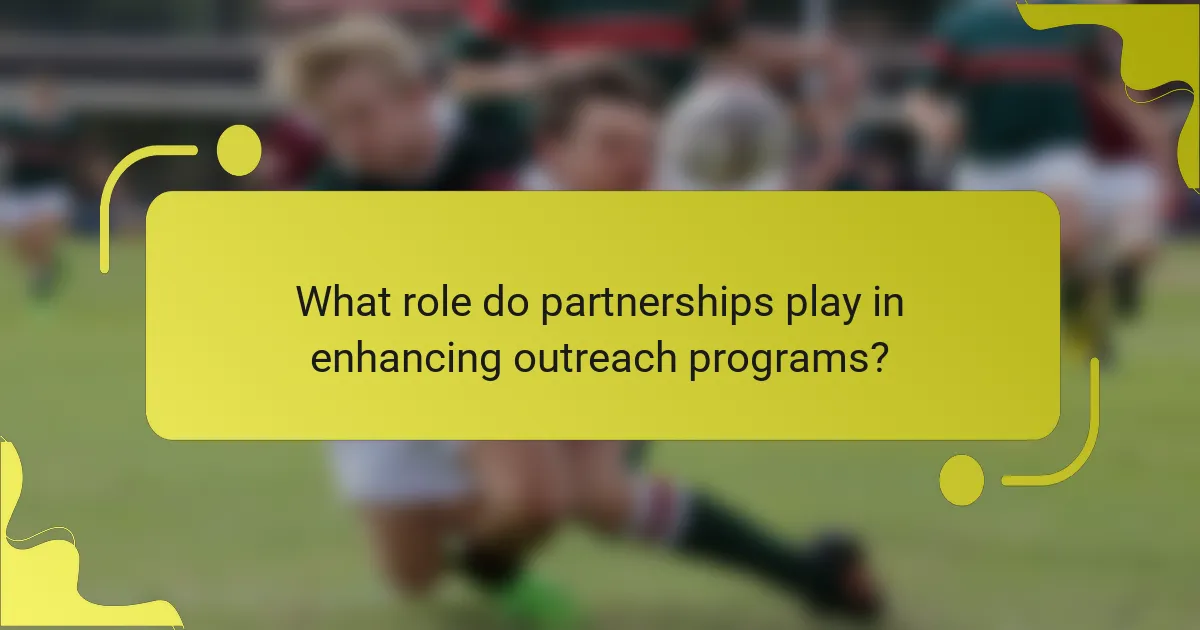
What role do partnerships play in enhancing outreach programs?
Partnerships significantly enhance outreach programs by expanding resources and networks. Collaborations with local organizations, schools, and businesses create a broader support system. This synergy fosters community engagement, increases participation rates, and enhances program sustainability. For example, partnerships can provide access to facilities, funding, and volunteers, ultimately building resilience within the community.
Which organizations are key collaborators in successful initiatives?
Key collaborators in successful sports outreach programs include local schools, community organizations, government agencies, and non-profit groups. These entities work together to enhance resilience and foster community connections. For example, local schools provide access to facilities and students, while community organizations mobilize volunteers and resources. Government agencies often offer funding and support, and non-profits focus on specific outreach initiatives. Collaboration among these groups maximizes impact and ensures sustainability in sports outreach efforts.
How can local businesses contribute to program sustainability?
Local businesses can significantly enhance the sustainability of sports outreach programs through financial support, resource sharing, and community engagement. They can provide funding for equipment, facilities, and scholarships, ensuring ongoing program viability. Additionally, businesses can offer venues for events or training sessions, fostering a collaborative environment. Community involvement strengthens local ties, creating a network of support that reinforces program resilience. This partnership not only benefits the outreach programs but also promotes the businesses within the community.
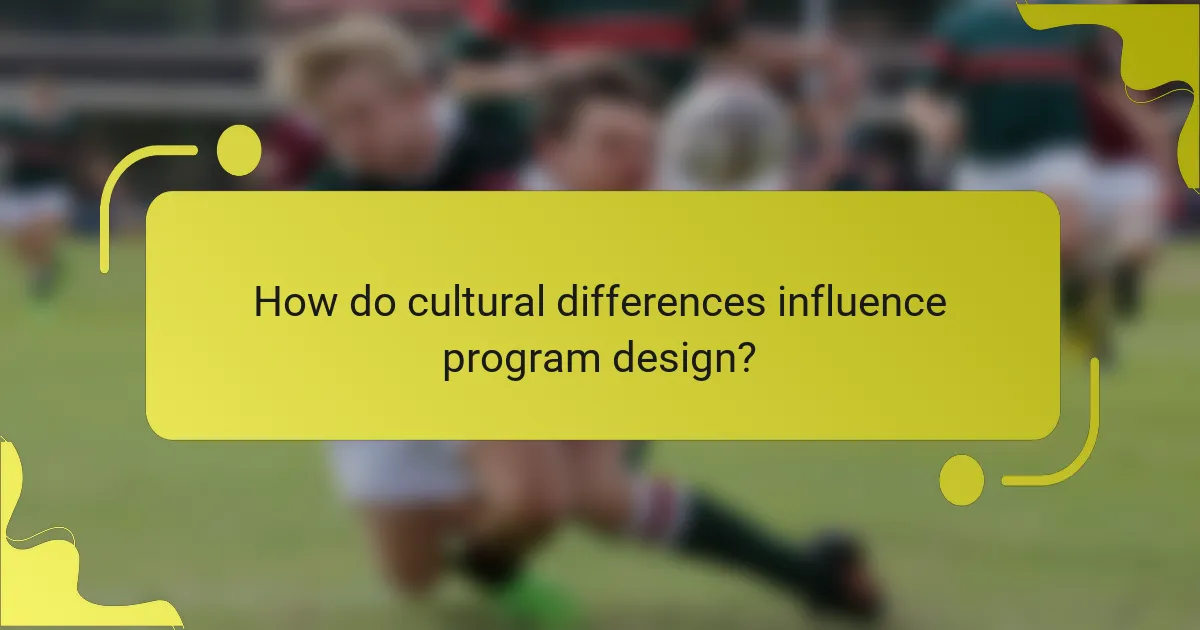
How do cultural differences influence program design?
Cultural differences significantly shape sports outreach program design by influencing participant engagement and community connection strategies. Programs must consider local values, traditions, and communication styles to ensure relevance and effectiveness. For example, incorporating culturally significant sports can enhance participation and foster a sense of belonging. Moreover, understanding cultural attitudes towards competition and teamwork informs program structure, impacting resilience-building efforts. Tailoring outreach initiatives to reflect community diversity leads to stronger connections and promotes inclusivity.
What adaptations are made for diverse community needs?
Sports outreach programs adapt to diverse community needs by customizing activities and resources. These programs often assess local demographics to tailor engagement strategies. For example, they may offer multilingual coaching for non-English speakers, ensuring inclusivity. Additionally, they might provide specialized training for individuals with disabilities, promoting access to sports. Programs frequently collaborate with local organizations to identify unique community interests, fostering deeper connections and resilience.
How does regional popularity of sports affect program focus?
The regional popularity of sports significantly influences the focus of outreach programs. Programs often tailor their activities to align with local interests, maximizing community engagement.
For instance, in areas where basketball is prevalent, outreach may prioritize basketball clinics and tournaments. Conversely, regions favoring soccer might emphasize soccer camps and leagues. This alignment fosters stronger connections and enhances participation rates.
Additionally, understanding regional preferences allows programs to allocate resources effectively. Programs can invest in equipment and training specific to the sports that resonate most with the community. This targeted approach builds resilience, as communities rally around shared interests, creating lasting bonds and support networks.
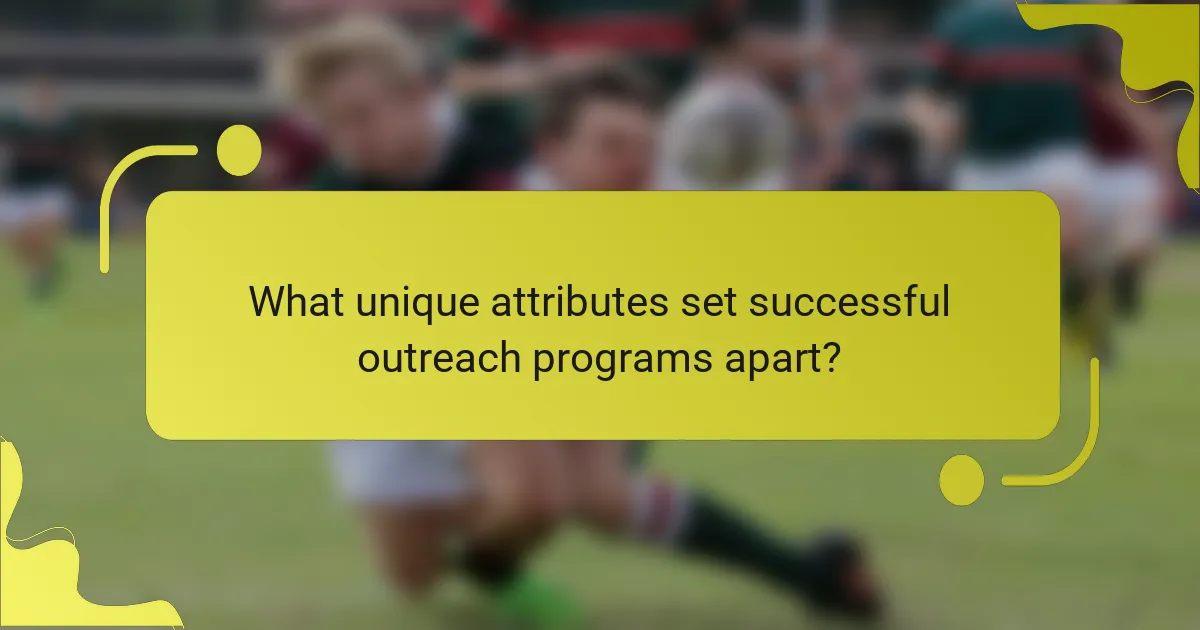
What unique attributes set successful outreach programs apart?
Successful outreach programs stand out by fostering genuine community engagement and adaptability. Unique attributes include strong local partnerships that enhance resource sharing and support systems. Programs that integrate feedback loops from participants demonstrate responsiveness, ensuring continuous improvement. Additionally, successful initiatives often leverage diverse funding sources, allowing for sustainability and innovation in their approaches. These attributes collectively build resilience and deepen community connections.
How do innovative training methods enhance participant experience?
Innovative training methods significantly enhance participant experience by fostering engagement and adaptability. These methods, such as gamification and experiential learning, create dynamic environments that encourage active participation. As a result, participants develop resilience and stronger community connections. Evidence shows that programs utilizing interactive techniques can increase retention rates by up to 60%, highlighting their effectiveness. Additionally, these approaches cater to diverse learning styles, ensuring inclusivity and maximizing impact across various demographics.
What role does technology play in modern outreach initiatives?
Technology enhances modern outreach initiatives by improving communication, engagement, and data management. Digital platforms facilitate real-time interaction, enabling sports outreach programs to connect with diverse communities. Social media, for instance, fosters community building and awareness. Mobile applications streamline participant registration and feedback collection, increasing program efficiency. Data analytics provide insights into participant needs, allowing for tailored programming. Overall, technology is integral to expanding reach and fostering resilience in sports outreach efforts.
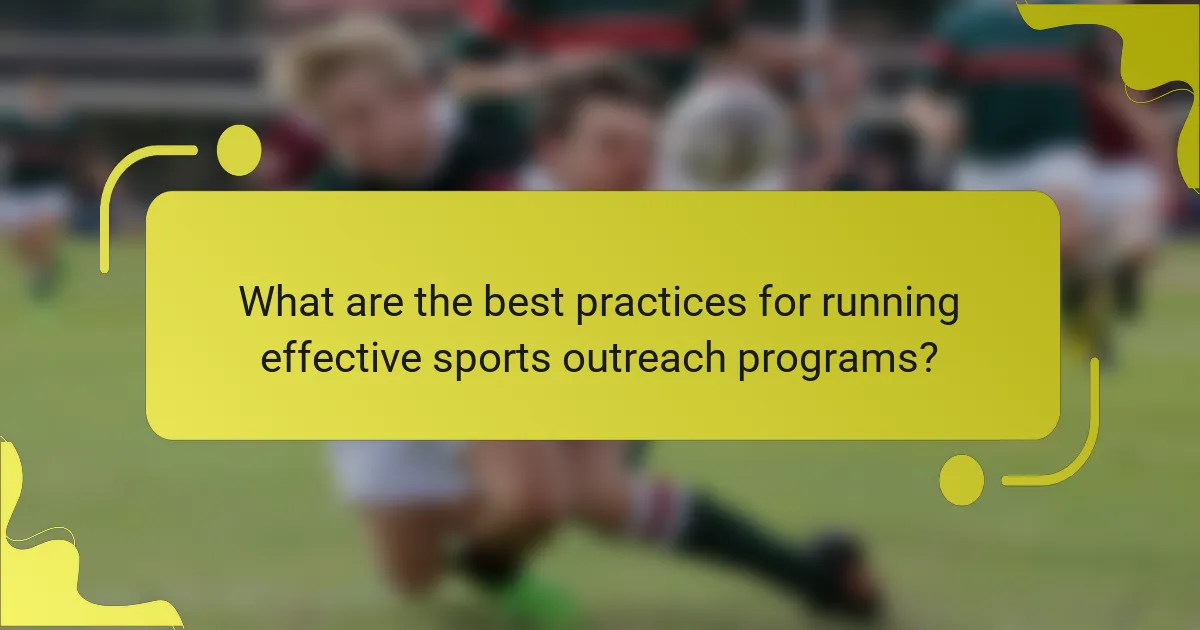
What are the best practices for running effective sports outreach programs?
Effective sports outreach programs prioritize community engagement, inclusivity, and sustainable practices. Key best practices include establishing partnerships with local organizations, focusing on youth development, and providing accessible resources.
1. Build strong community partnerships to leverage resources and expand outreach.
2. Tailor programs to meet the specific needs of diverse populations.
3. Implement training for volunteers to enhance program delivery and participant experience.
4. Measure program impact through participant feedback and performance metrics.
5. Foster a culture of inclusivity to ensure all community members feel welcome.
6. Promote ongoing engagement through events and follow-up activities.
How can program leaders engage volunteers effectively?
Program leaders can engage volunteers effectively by fostering a sense of community and purpose. Establish clear roles and responsibilities to align volunteers with program goals. Regular communication builds trust and keeps volunteers informed and motivated. Offering training and skill development enhances their experience and commitment. Recognizing and celebrating contributions creates a positive environment that encourages ongoing participation.
What strategies can be implemented to maximize community involvement?
To maximize community involvement in sports outreach programs, implement strategies that foster engagement and connection. Organize regular community events to encourage participation and build relationships. Leverage local partnerships with schools and organizations to expand reach. Utilize social media platforms for communication and promotion, ensuring visibility. Provide training and mentorship opportunities to empower community members, enhancing their skills and confidence.
What common mistakes should be avoided in program execution?
To avoid common mistakes in executing sports outreach programs, focus on clear communication, proper planning, and community engagement.
Lack of clear objectives can lead to confusion and misalignment among stakeholders. Insufficient planning may result in missed deadlines and resource misallocation. Failing to engage the community diminishes program relevance and support. Additionally, neglecting to measure outcomes can hinder future improvements. Prioritize these areas to enhance program effectiveness and foster resilience.
